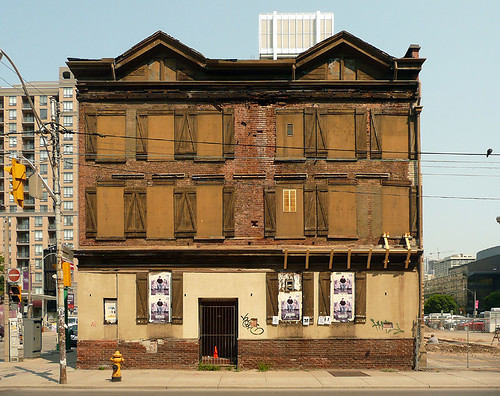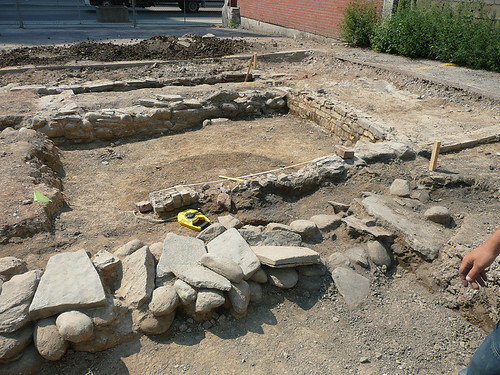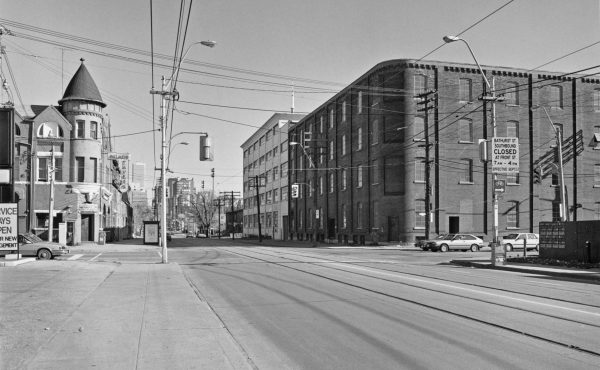
At the corner of University and Adelaide, an empty parking is slowly being converted into a luxury condo. But in my opinion, its the heritage building — known as Bishop’s Block — and the recently discovered archaeological finds that are the real gems of the site.
Bishop’s Block was constructed in 1829 and was later converted into the Adelaide Hotel in the 1850s. It was last used in the 1970s as a bar (known as the Pretzel Bell Tavern) and was one of the favourite watering holes of Maple Leaf legend/showman Eddie Shack. The second, third, and fourth floors have been inactive since the late 1940s, yet stylized wallpaper from that era still exists. Sadly, a hole in the roof that appeared in the early 1990s has contributed to the near-destruction of the top floors and has created a rather toxic environment for anyone exploring the interior of the building. The leak washed out the lime mortar that held the bricks together and rotted the wood structural timbers, causing the south faà§ade to buckle and sag to the point of near collapse. In 2007, temporary structure was erected inside and outside of the building to slow this movement.

The Bishop’s Block faà§ade will be incorporated into the 63-floor Shangri La luxury condo development slated to open in 2011. An archaeological dig, located on the old building’s east side, revealed a plethora of artifacts as well as a few cisterns. Shangri-La has agreed to showcase the archaeological treasures in the condo’s foyer when tenants move in. The dig has recently concluded, paving way for condo construction to begin.
In an interesting twist, to save the faà§ade of this heritage building it first must be torn down. This process has already begun — if you walk by University and Adelaide, you can see the building being deconstructed brick by brick. The complete failure of the structural system resulted in the building’s being unable to withstand the vibrations that would be produced during the construction of the adjacent building. The eight floors of underground parking required for the building means construction will have to go deep into the city’s underlying bedrock. This heavy construction process could create enough ground vibration to fell the fragile heritage building. Once the condo construction nears completion in 2010, Bishop’s Block will be rebuilt in its original location, adjacent to the Shangri La.




21 comments
Despite being another example of Toronto’s ‘facadeism’ approach to heritage conservation, this is one of those rare occasions when retaining just the facade is an appropriate compromise. Given the state of the building there likely wasn’t a great deal of heritage fabric left to work with and since we know that neglected buildings like this can easily collapse (as was the case with Walnut Hall last May) I feel content just knowing that it will be at least partially saved. I sincerely hope the developer keeps his promise and displays the archaeological remains. These are important to giving the area some badly needed historical context and shouldn’t just be for hotel guests or residents of the building.
I can see Bishop’s Block as I write this (I work at 200 University) and I’m pretty sure the prospective condo buyers don’t know about the delightful Simcoe St sewer vent that lurks outside the door. Most days, the smell is merely bad, but after rain, it’s enough to make your gorge rise.
Back in the ’70s, the old Weston bakery–now George Brown College,King St. campus–was gutted with only the external walls standing and reinforced. It’s a pity that an end use for Bishop’s Block couldn’t be found so as to restore and re-use the building.
It has some architectural and historical merit but many people will remember it as the Pretzel Bell Tavern,the watering hole for the Toronto Sun employees when their first offices were at 322 King St. W. Number 322 still stands and will be opposite the new Film Festival headquarters.
What’s the point? It doesn’t look like a very significant facade, and the main level has obviously been greatly altered.
Oh, and “….eight floors of underground parking required for the building….”?!?!
The point is that it’s one of the oldest surviving buildings in Toronto. 1829!
The archaeological dig was cool. I led a group of youth on a walking tour in the area during the summer, and they were really excited by the archaeology dig. I talked to some of the people doing the dig, and it was basically of the back yards of a set of row houses – you could see the foundations, the cisterns, possibly the outhouse. It was cool to see that a city as young as Toronto still has layers to it.
Devils advocate:
While it might be the one of the oldest surviving buildings in Toronto, unfortunately if we insisted on preserving every old building ever build in Toronto nothing new would ever be built (and the developers, rightly so, would say ‘nuts to this, I’m going to Mississauga where I don’t have to put up with this crap!’).
I mean, we’ve already got a few city-owned museums in old buildings, I just dont see what we stand to benefit from preserving every artefact we stumble upon. You know, looking forward, not back, yadda yadda..
I’m glad Ian wasn’t in charge when there were plans to tear down Old City Hall and Union Station.
I have worked in the very near vicinity of the Bishop’s Block for the last 13 years. While I had heard that it was a Toronto heritage site, I never knew its name or any of its historical information (other than it had been a pub that Eddie Shack used to patronize) until this summer when the archeological dig was taking place. I am curious, with the current deconstruction of the building – brick by brick as Matthew Blackett writes, as to where (and how) the original bricks were made; and, whether these bricks will be able to be re-used when the building is reconstructed. The Don Valley Brick Works (itself now an historical site) did not start production until 1889 and this building was constructed 1829-30.
I’m glad Ian knows the difference between historic landmarks (Old City Hall, Union Station) and a regular old building (Bishop’s Block).
Is this also the building that was “Z School” ; a break away art school from OCA during the late 70’s ?
It’s not “any old building”. It’s one of only a handful that survive from the earliest years of Toronto. There aren’t any more where this came from. Almost all have already been demolished to build new buildings, this one happens to survive, and as such it provides a link to the past that cannot, in any way, be replaced if it is completely lost. Its rarity makes it valuable.
And it’s obviously not standing in the way of progress – rather, it’s being incorporated into progress, in the form of a brand-new, very large condo tower. And I bet the fact that there’s some character in the neighbourhood in the form of surviving old buildings will make those condos more valuable.
And remember: it isn’t exactly “facadism” in the matter opponents loathe–the only reason it’s being done in this manner is due to structural conditions; but otherwise, it’s perfectly legitimate. Indeed, with judicious salvaging rather than too-hasty clearing of the collapsed remains, even Walnut Hall could (I’d have hoped) have been resurrected in such a manner without seeming needlessly, obnoxiously faux. (And there’s also the illustrious precedent of St. Lawrence Hall, whose east wing collapsed during restoration in 1967, yet was quickly, almost seamlessly resurrected.)
It’d be more truly “facadism” if it were but an obviously stuck-on postage-stamp slice of Bishop’s Block, with disregard for plan, scale, etc. As it is, perhaps the biggest problem the heritage community might have is more of a macro-issue, i.e. its seeming a token preserved mouse next to a superscraper.
As for Ian’s comment: maybe we *don’t* need the ‘nuts to this, I’m going to Mississauga where I don’t have to put up with this crap!’ school of developers? It’s like McMansion mentalities vs the Annex: okay, so good riddance, and don’t let the door hit you on the way out…
It WILL be demolished, except for a thin veneer of brown bricks that are no different from a million others. Which will look stupid pasted onto the front of the shiny, glass tower.
Nah. I love glass towers and super modernism welded to the old and historic. It’s one of the reasons I love the new ROM. Keep some old, allow for some new. Only the history ideologues are uptight about it.
“Which will look stupid pasted onto the front of the shiny, glass tower.”
Actually, the facade is *not* being pasted onto the tower. It’s being incorporated into a resurrected Bishop’s Block–which, in a manner of speaking, is being pasted on top of the underground garage…
“resurrected Bishop’s Block”, i.e. a totally new structure?
And the grand, old ROM hardly compares to one layer of plain, old brick.
Well, blame it on structural conditions. Were it more structurally sound, they might have jacked it up and moved it to one side while they built the garage underneath. But they couldn’t; so, this is the optimal solution under the circumstances.
And if it’s still just “plain, old brick” to you, then at this point you might as well be making the paint-roller argument re colour-field abstraction.
Look: not all “historic landmarks” have to be obviously prominent and ooh-aah spectacular a la Old City Hall, Union Station, the ROM. Like said paint-roller argument, that’s ignorant yahoo judgment. You might as well be those tasteless mouth-breathers who slather that dreadful EIFS stucco on “plain, old brick” houses, storefronts, etc–if those are the kinds of jerkwads who wind up saying ‘nuts to this, I’m going to Mississauga where I don’t have to put up with this crap!’, well, then, good riddance.
Ian >…because there aren’t enough new buildings in Toronto and the developers don’t have enough sway already?
Which will look stupid pasted onto the front of the shiny, glass tower.
We emigrated to Canada in 1986, and shortly thereafter were taken to a park in which large pieces of masonry of old Toronto buildings had been preserved in a lush green meadow, many showing porticoes with names and dates engraved on the facade. There was a restaurant attached to this attractive park – somewhere in the East or the Beaches area.
I have not been able to trace the whereabouts of this breath of old Toronto, and the many residents I have asked have been unable to help.
Can anyone please give me some detail of this? Iy should be prominently advertised
Lee Dickman
416-531-64645
Guild Inn, Lee. Still there, and lovely:
http://www.toronto.ca/culture/the_guild.htm